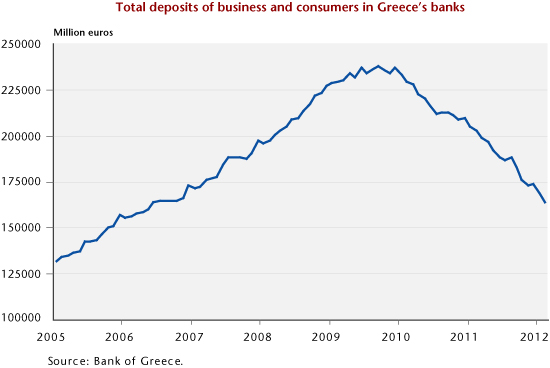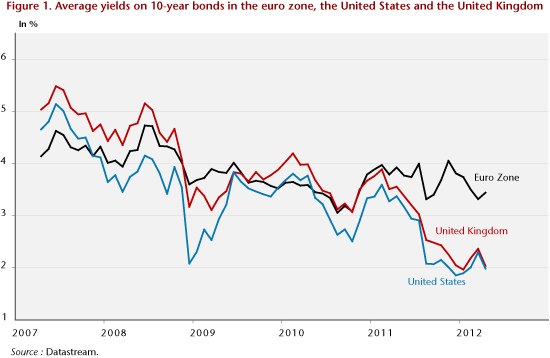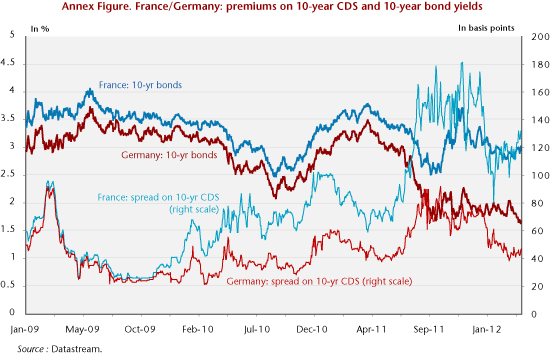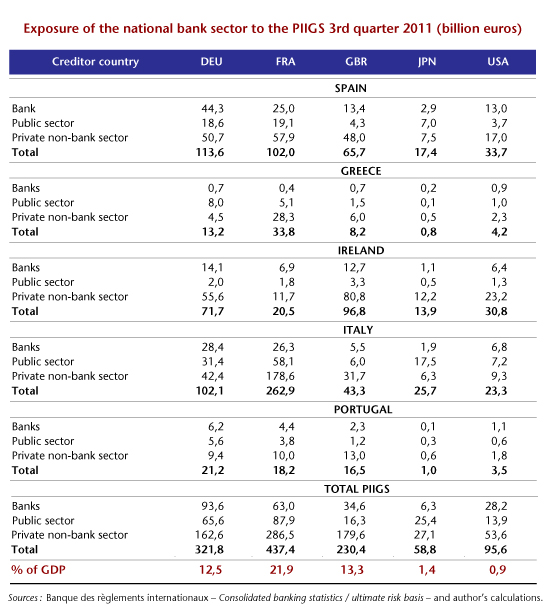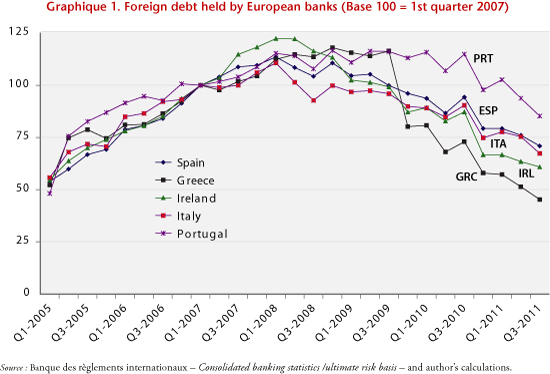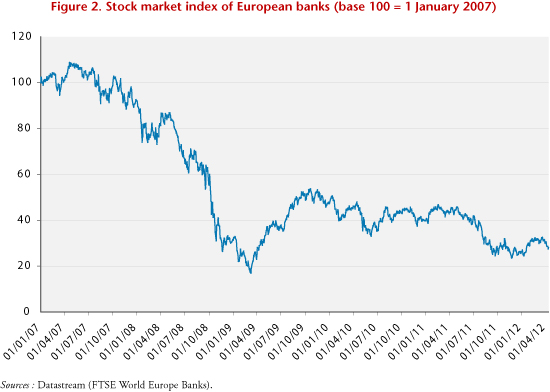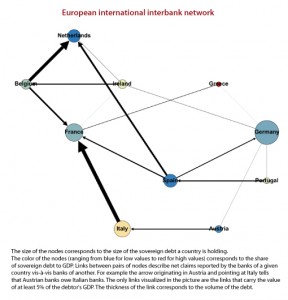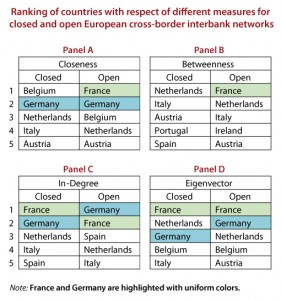The law on the separation of banking activities: political symbol or new economic paradigm?
By Céline Antonin and Vincent Touzé
Imprudence, moral hazard and systemic gridlock were key words for the banking crisis. Governments that were unhappy to have had no choice but to come to the rescue of the banks are now trying to regain control and impose new regulations. The regulations with the highest profile concern the separation of trading activities (trading on own account or for third parties) from other banking activities (deposits, loans, strategic and financial consulting, etc.). These are expected to have the advantage of creating a tighter barrier between activities, with the idea that this could protect investors if bank operations go badly on the financial markets. On 19 February 2013, the French Parliament passed a law on the separation of banking activities. Although the initial targets were ambitious, the separation is only partial, as only proprietary financial activities will be spun off. As these cover less than 1% of bank revenues, this measure tends to be symbolic. However, by giving legal force to the principle of separation, the State is demonstrating its willingness to take a more active role in supervision.
The idea of compartmentalizing banking activities is not new. In the aftermath of the 1929 crisis, the United States adopted the Glass-Steagall Act (1933), which required a strict separation between commercial banks (specialized in lending and in managing deposits) and investment banks (specialized in financial activities). France followed suit with its own banking law of 1945 [1]. The expected benefits of separating banking activities are twofold. On the one hand, customers’ deposits would be better protected, because they could no longer be asked to absorb the potential losses of market activities; on the other hand, in case of bankruptcy, State aid would be limited, because only the retail part of the bank would be covered by a government guarantee.
Forty years later, in the wake of the major wave of deregulation in the 1980s-1990s, France was one of the first to abolish this distinction, with the Banking Act of 1984, thus establishing the principle of universal banking. This principle leads to grouping activities with high needs for liquidity (the financing of the economy) with those that make it possible to gather liquidity (deposit activities). This grouping has the undeniable merit of giving the banks a more solid financial foundation. Other benefits also flow from this: greater leverage; the size factor leads to economies of scale; and the banks’ ability to internationalize allows them to join the “too big to fail” category. Across the Atlantic, these arguments certainly worked in favour of the abolition of the Glass Steagall Act in 1999 by the Clinton administration.
Since 2008, the banks have been hit by a number of shocks: the subprime crisis; the fall in financial stocks; the slump in economic growth; and fear of defaults on sovereign debt (for banks in the euro zone). These shocks have shown that some of the advantages of universal banking could turn into disadvantages if leverage is used too systematically and if large banks in difficulty begin to pose a systemic risk. Many voices then began to be heard advocating a new Glass-Steagall Act, based on a view that separating market activities [2] from other banking activities is a way of preventing large-scale banking crises. Trading on own-account activities concentrates the bulk of bank malfunctions, in particular reckless risk-taking and the occasional “mad” trader [3]. This compartment has thus now become the focus of increasing attention by the regulators.
The Dodd-Frank Wall Street Reform and Consumer Protection Act [4] adopted in the United States in 2010 did not establish the separation of banking activities in a strict sense, but adopted the “Volcker rule,” which prohibits banks from “playing” with depositors’ money. This led to a virtual ban on the speculative proprietary activities of banking entities as well as on investments in hedge funds or private equity funds. In addition to this rule, this Act also represented a major reform in favour of the tighter regulation of all financial agents (banks, insurance companies, hedge funds, rating agencies, etc.) as well as closer monitoring of systemic risks.
Europe is in turn planning legislation on the separation of banking activities. At the request of European Commissioner Michel Barnier, the group of experts led by the Governor of Finland’s Central Bank, Erkki Liikanen, presented a report on 2 October 2012. It advocates a strict bank compartmentalization [5] but also reviews the remuneration of financial managers and traders, with a view to overhauling the current arrangements, which tend to “push people into crimes” such as excessive speculation, in order to make these arrangements more compatible with long-term objectives. If this report is turned into a European directive, it will then have to be transposed into the national law in each Member State. However, this Europe-level approach is likely to be overtaken by the legislative processes in several European countries. In Germany, a bill on banking regulation [6] was introduced by the government on 6 February 2013, and could enter into force by January 2014 (with implementation by July 2015). The United Kingdom stood out in 2011 with the publication of the Vickers report [7], although the British government is in no hurry to implement its recommendations, with a probable deadline of 2019. France, with its “law on the separation and regulation of banking activities”, has not been left behind.
A MODEST FRENCH ACT …
The French law has several components. In addition to establishing the principle of separation, it also provides for measures to protect bank clients and to strengthen the supervision and control of the banks.It does this in several ways:
– Each bank will be forced to develop a preventive recovery plan [8] for dealing with a crisis and a resolution plan in case it is failing (a bank testament). The resolution plan will be submitted for the appreciation of the Prudential Control Authority (ACP), which becomes the Prudential Control and Resolution Authority (ACPR).
– The Deposit Guarantee Fund (FGD) becomes the Deposit Guarantee and Resolution Fund (FGDR), with an increased capacity to intervene in the event of a bank failure.
– Macro-prudential supervision is strengthened by the establishment of the Financial Stability Council (CSF).
– The rights of bank clients are enhanced (transparency on the cost of loan insurance, free choice of loan insurers, right to a bank account, etc.).
However, the flagship measure in the reform is the separation between “activities useful to the economy” and speculative activities. Banks are to confine their proprietary or “own account” activities in an ad hoc subsidiary that is subject to specific regulation and funded independently. These subsidiaries will be prohibited from practicing certain speculative activities that are deemed “too risky or that may be harmful to the economy or society”, such as activities on the markets for derivatives whose underlying assets are agricultural commodities, or high-frequency trading. Many activities will nevertheless be spared, such as providing services to customers, market-making activities, cash management, and bank investment or hedging operations to cover its own risks.
This law separating bank activities, which was initially presented as ambitious, will ultimately have only a limited impact. The universal banking model is not called into question. The admission of the head of the Société Générale bank could not be any clearer [9]: less than 1% of revenues are concerned. We are therefore a long way from how banking was compartmentalized prior to 1984. The criterion for separation is ambiguous. In fact, the border is porous between hedging risk and pure speculation: the law advances a fuzzy principle of “economic relevance”, and the banks may be tempted to play around in this legal vacuum. As for market making [10], it is difficult to distinguish between speculative proprietary activities, which have to be spun off, and activities to promote market liquidity: high-frequency trading is for instance usually practiced under the guise of market-making agreements, so the law may be no more than a sword slashing water if the status of market maker is not defined more precisely [11].
The law also provides for prohibiting a banking group from holding shares of a speculative type, like a hedge fund. However, the loans granted by banks to hedge funds are always accompanied by guarantees. From this point of view, the law will also have little impact.
… BUT COULD IT GO FURTHER?
Finding a new financial paradigm for a banking model is a complex exercise. In practice, it is not easy to separate banking activities purely and simply without causing problems, and there are generally many limits to banking reform.
First, limiting investment banks’ access to deposits as a source of liquidity, or eliminating this outright, would lead them to resort to more debt financing, which might be difficult to reconcile with the constraints set by the Basel III prudential regulations, which took effect on 1 January 2013. It is already very demanding in terms of equity levels.
Furthermore, it is important to note that banking risk is not inherent just in market activities. There are many other recent examples. Mortgage lending has also been an important source of risk: in Spain, falling house prices and the insolvency of borrowers virtually bankrupted the banks; in the United States, the subprime crisis is a crisis of real estate loans that affected the markets through sophisticated securitization mechanisms that allowed the banks to take the risk off of their balance sheets (at least ostensibly); in the UK, Northern Rock is a retail bank that specialized in mortgages and was hit hard by the credit crunch and the housing crisis. To some extent, universal banks have played an important role in saving banks that were too specialized, for example, JPMorgan Chase (Universal) took over Washington Mutual (savings and loan) and Bear Stearns (business), and Bank of America (universal) rescued Merrill Lynch (business).
In addition, the separation is supposed to wall off banking activities more tightly. But what happens if the subsidiary that manages the proprietary speculation goes bankrupt and causes heavy losses to the parent? In the past, two of the four major French groups, Crédit Agricole and BPCE, had insulated their market activities in their respective subsidiaries, Natixis and Cacib, but nevertheless had to come to their rescue in 2008 and 2011, respectively. The insulation seems to be very permeable.
In a context of financial globalization, compartmentalization may never be very effective. By its very principle globalized finance makes it possible to connect everything. This is in particular the role of the interbank markets [12].
In practice, it is difficult for a government to reform its banking sector in the absence of coordination with other countries. The domestic banks have foreign subsidiaries that may not be subject to the regulations. And above all, the profitability of rival foreign banks might improve, which would weaken the competitiveness of the domestic banks. At the European level, national interests differ, and each country may be tempted to impose its own bill. If the Liikanen report is turned into a Directive, then each Member State will be required to transpose it into their legal system. For the moment, the legislation of Germany and France is taking the lead. It is possible that these changes will influence any future directive.
If the effort to compartmentalize goes too far, there is also a risk of shifting the interconnections to less visible levels. It is essential to avoid falling into the trap posed by the dangerous illusion of thinking that we have eliminated a risk, when in fact it has just been moved.
Finally, too much regulation can sometimes kill regulation. In the financial sector, regulatory constraints may serve as a basis for speculation. So if a bank is having difficulty meeting certain regulatory constraints, the markets will be encouraged to speculate in order to provoke its failure and then profit from this. Caution is therefore needed before introducing new regulations.
Trying to apply the principle of separation too strictly could also lead to not supporting a commercial bank that is facing significant liquidity problems. However, according to the principle of “too big to fail”, such a decision is not always wise. The failure to support Lehman Brothers was punished in a way that had a significant long-term impact, as its collapse hit the entire economic and financial network.
It is also worth noting that taking banking and financial regulation to be a miracle cure could have deleterious effects on individual and collective responsibility. People think that the law can resolve any problem. Yet at the same time, it is very likely that the vectors of the next financial crisis will manage to circumvent the regulatory constraints, hence the importance for the supervisory authorities to remain vigilant and adopt a critical approach at all times.
GOING BEYOND THE POLITICAL SYMBOL
The government undeniably has little leeway to separate banking activities, because too much regulation may be ineffective or even dangerous. As a consequence, this law separating banking activities is not radical and will have a moderate effect on the banks. For its part, the government may have a clear conscience for having done something along the lines of its foreign counterparts. The bankers in turn are probably not unhappy at having given the impression of serving the public interest, especially at such a low cost.
Some will view this as just a poor political symbol. Others will try to go further and view this as giving hope that this reform will be seen as a strong signal to the banking world. This hope may not be in vain, as the principle of separation is now enshrined in law, and future governments will have plenty of time to strengthen it.
In practice, a change in economic paradigm that would lead to harmful speculation becoming increasingly rare will not result simply from a separation of activities. Banking laws should not be too complicated, because the devil has a tendency to hide in the details. The supervisory authorities must constantly keep a critical eye on the functioning of the markets, and the law needs to allow them some flexibility in determining when and how they should intervene. On these issues, Volcker’s statement in 2011 is unambiguous [13]: “I’d write a much simpler bill. I’d love to see a four-page bill that bans proprietary trading and makes the board and chief executive responsible for compliance. And I’d have strong regulators. If the banks didn’t comply with the spirit of the bill, they’d go after them.” It is also worth examining various measures to make financial professionals (managers and market operators) more responsible. In this respect, the Liikanen report proposes revising the pay systems for bank executives and financial managers in order to make these systems more compatible with a long-term vision. It is also necessary to explore the possibility of increasing the criminal liability [14] of financial leaders. The permeability of the interface between careers in the regulatory sector and in the regulated sector also needs to be examined. In this regard, there are certainly ways to make the system less permeable. After all, recent history has shown that it is possible to go from being Chairman of the Fed to being a trusted advisor for a rich and powerful hedge fund….
[1] Law 45-15 of 2 December 1945 provided for the specialization of financial institutions by classifying the banks in three categories: deposit banks, business banks and long-term and medium-term lending banks (Articles 4 and 5).
[2] Asset management can be exercised:
– for one’s own account (proprietary trading): the bank buys or sells financial instruments that are funded directly out of its own resources. These resources include not only the bank’s capital, but also savers’ deposits and loans. This means that, in addition to its own funds, the other categories involved in the bank’s financing, including customer deposits, indirectly bear a risk.
– or on behalf of third parties (non-proprietary trading): unlike proprietary trading, the market or borrowing risks are borne mainly by the client. However, on certain products, the bank could face significant operating risks.
[3] http://lexpansion.lexpress.fr/economie/trading-pour-compte-propre-la-face-cachee-des-banques_233686.html.
[4] Title VI of the Act proposes improving regulation and is considered to be an application of the “Volcker Rule”, http://useconomy.about.com/od/criticalssues/p/Dodd-Frank-Wall-Street-Reform-Act.htm.
[5] The report recommends a separation of proprietary market activities but also of certain other activities on the financial markets and derivatives for third parties.
[6] Germany is also preparing a bill, under which the German banks will be obliged to wall off their proprietary trading. As in France, the universal banking model will not be called into question. http://m.lesechos.fr/redirect_article.php?id=reuters_00495696&fw=1.
[7] In September 2011, the Vickers Report recommended separating retail banking services from investment activities, by ringfencing retail banking services in subsidiaries, along with the requirement of a 10% equity cushion for retail banks. The British government is committed to introducing the reforms into law by 2015, with implementation set for 2019.
[8] This plan provides for different possibilities for recovery (recapitalization, a savings plan, restructuring, etc.) and excludes any call for public financial support.
[9] “We believe that, while in 2006-2007, 15% of activities could be considered market activities, 15% to 20% of which could be classified as disconnected from the customer, and consequently transferred to a subsidiary, this proportion is now less than 10%, and ranges from 3.5% to around 5% on average.” Frédéric Oudéa, 30 January 2013, at a hearing before the Finance Committee of the National Assembly, http://www.assemblee-nationale.fr/14/pdf/cr-cfiab/12-13/c1213060.pdf.
[10] Market-making corresponds to the permanent presence of an operator who provides liquidity to the market.
[11] In this respect, we should mention the amendment tabled by Karine Berger, who wants Bercy [the Ministry of the Economy] to set the threshold above which market activities must always be spun off.
[12] Since 2008, the crisis of confidence in the banking market has posed great difficulties for access to liquidity in some banks, even though they are perfectly solvent, which has forced the central banks to intervene and take the place of the interbank market.
[13] 22 October 2011, http://www.nytimes.com/2011/10/22/business/volcker-rule-grows-from-simple-to-complex.html?pagewanted=all&_r=0.
[14] In this respect, the American authorities have not hesitated to take action against financial institutions that have failed to meet their obligations. See, for example, the recent action taken against Standard & Poor’s, http://www.bloomberg.com/news/2013-02-06/s-p-lawsuit-portrays-cdo-sellers-as-duped-victims.html. See too the proceedings taken against a former employee of Goldman Sachs: http://www.sec.gov/litigation/complaints/2010/comp-pr2010-59.pdf and http://dealbook.nytimes.com/2013/01/31/trader-accused-of-misleading-clients-leaves-goldman/ or the investigation into the infamous “London whale”: http://www.reuters.com/article/2013/02/15/us-lehman-jpmorgan-londonwhale-idUSBRE91E00W20130215.
